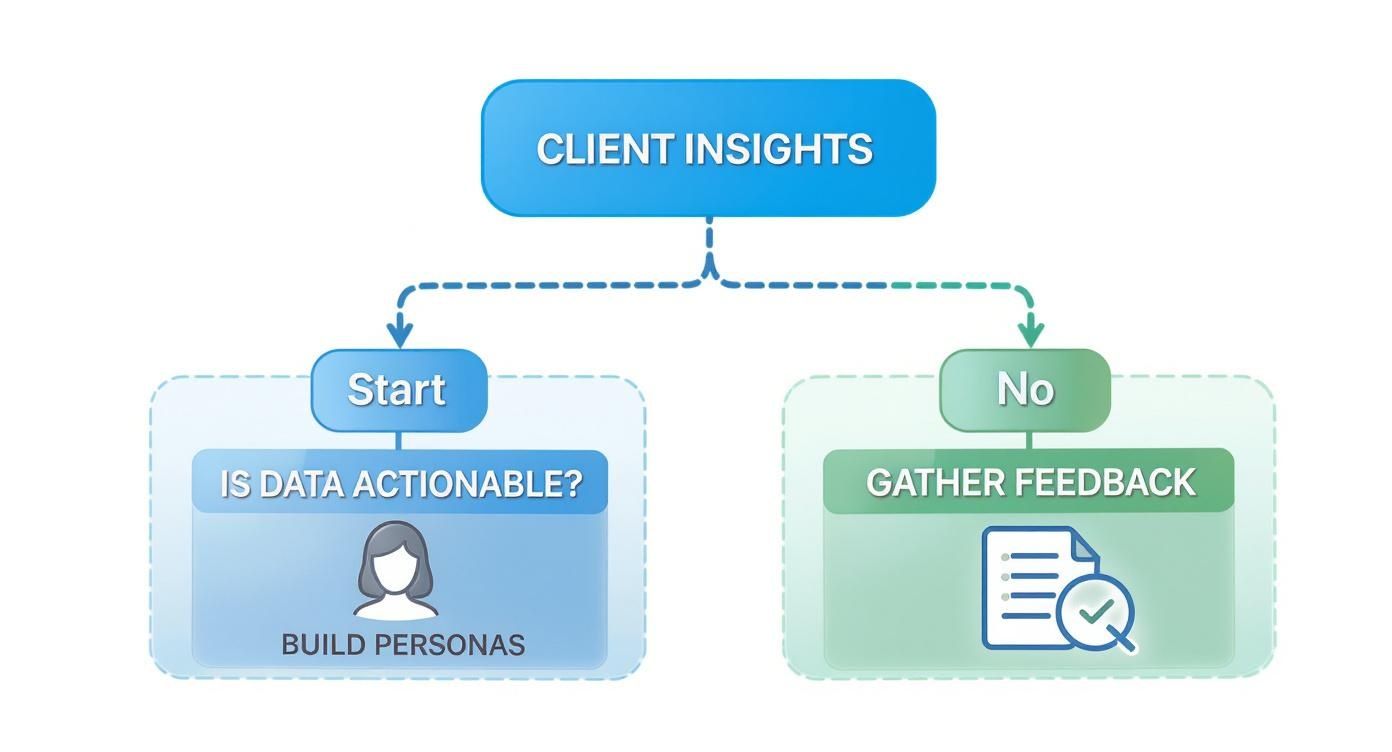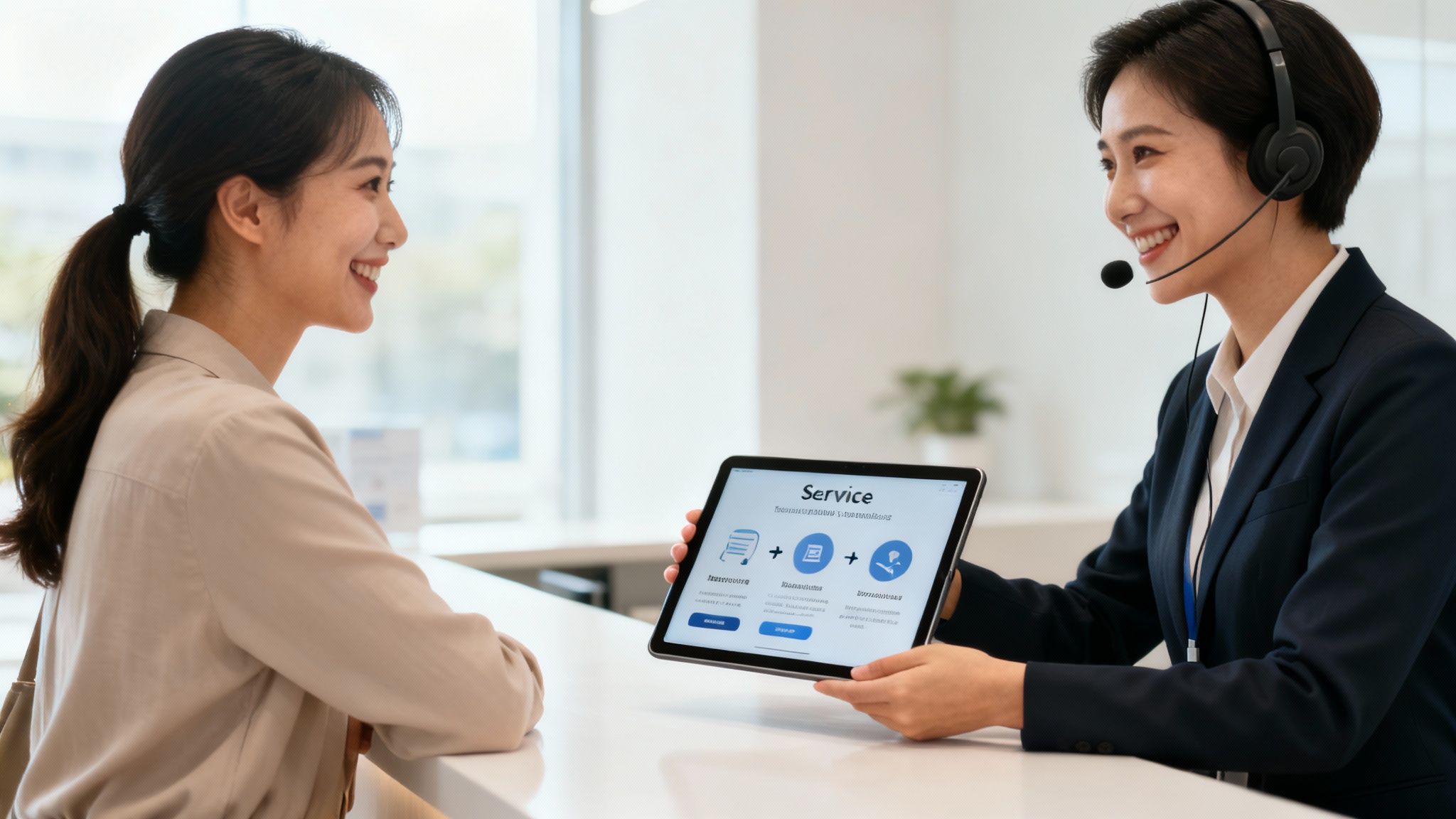Ever wonder what separates businesses that just have clients from those that build genuine, lasting relationships? It all comes down to a client engagement strategy.
This isn't just about good customer service. Think of it as the complete blueprint for every single interaction a client has with your business—from their very first click on your website to the follow-up email you send after a job is done. It’s a deliberate plan designed to build loyalty and drive real growth.
Why You Can't Afford to Ignore Client Engagement
Let's cut through the jargon. A solid client engagement strategy isn't some fluffy "nice-to-have." In today's market, it's the bedrock of a successful business. It's about looking at the entire client journey and making sure every touchpoint is a positive one.

For any Australian business trying to get ahead, this proactive approach is non-negotiable. Customers today expect more than just a service; they want to feel seen, heard, and valued. When you consistently deliver that experience, the results show up directly on your bottom line.
The Real-World Payoffs of a Smart Plan
When you put a thoughtful strategy in place, you shift from just putting out fires to proactively building relationships. The payoff is huge and shows up in a few key ways:
- Higher Customer Lifetime Value (CLV): Engaged clients stick around. They buy from you again and again, which massively boosts their value to your business over time.
- Rock-Solid Brand Loyalty: When clients feel that connection, they become your biggest fans. That kind of loyalty is your best defence when a competitor tries to swoop in with a cheaper price.
- A Flood of Referrals: Let's be honest, happy clients are the best marketing team you could ask for. They're far more likely to recommend you to their mates, bringing in a steady stream of quality leads that are already warmed up.
A strong client engagement strategy isn't just about sending emails or making calls. It's a powerful tool for boosting performance, cutting down on acquisition costs, and building a more resilient, customer-focused business.
Getting this right means digging into the different ways you can create these deeper connections. It’s worth exploring the proven strategies for improving customer engagement that other successful teams are already using.
This kind of planning also forces you to look at whether your outreach is actually working. You have to know your numbers. Keeping an eye on key https://onsilent.com/productivity-tools/communication-metrics/ is essential for tweaking your approach and making sure you're hitting the mark. By measuring what works, you can keep refining your strategy so that every single interaction builds a stronger client relationship. It's not about being busy; it's about making every connection count.
Uncovering Deep Client Insights
A powerful client engagement strategy is built on one simple truth: you can't engage clients you don't genuinely understand. It’s easy to get caught up in basic demographics, but that’s just scratching the surface. To create interactions that feel personal and valuable, you need to dig into what really makes your clients tick—their motivations, their headaches, and their ultimate goals.
The good news? This doesn’t require a massive budget or complicated software. You can start gathering meaningful data with simple, effective tools that you probably already have access to.
Gathering Actionable Intelligence
The real goal here is to collect qualitative data that reveals the "why" behind what your clients do. This information is gold because it helps you build a strategy based on empathy, not just guesswork.
Start by mixing in a few listening tools:
- Targeted Surveys: Don't just ask if they're satisfied. Ask what their biggest challenge was before they found you, or what a "win" looks like for them in their day-to-day role.
- Feedback Forms: Pop a simple form at key points in their journey, like after a purchase or a support chat. Keep it to one or two specific questions to get more people to actually fill it out.
- Social Listening: Pay attention to the conversations happening in your industry on platforms like LinkedIn or even in Facebook groups. What questions are people asking? What frustrations are they constantly sharing?
This raw data is the foundation for everything that follows. It's how you move from guessing what clients want to knowing what they need.
An effective client engagement strategy hinges on turning scattered client data into a coherent story. When you understand that story, you can anticipate needs and create experiences that build lasting loyalty.
From Data to Detailed Personas
With this rich information in hand, you can start building out detailed client personas. These aren't just generic profiles; think of them as semi-fictional representations of your ideal clients, grounded in the real data you've just collected. A good persona brings your target audience to life, making it so much easier to craft messages that actually land.
Make sure your personas include the essentials:
- Primary Goals: What are they trying to achieve, either professionally or personally?
- Major Pain Points: What obstacles are constantly getting in their way?
- Preferred Communication Channels: Where and how do they actually like to get information?
Having all this information gives you a clear, unified view of your clientele. Of course, organising these details effectively is crucial. This is where exploring the best CRM programs for small business can be a total game-changer, keeping all your client insights accessible and actionable for the whole team.
When you centralise this knowledge, you ensure every interaction is informed and consistent. And that’s how you strengthen your client engagement strategy from the ground up.
Developing a Personalised Communication Plan
Right, so you’ve got a solid grasp of who your clients are. What’s next? It's time to build a communication plan that actually connects with them. The days of one-size-fits-all email blasts are long gone. The real goal is to shift from broadcasting generic messages to creating tailored interactions that feel personal, even when you're communicating at scale.
This isn't just about what you say, but also where and how you say it. A quick SMS is perfect for an urgent appointment reminder, but a detailed email is a much better fit for a monthly market update. When you match the channel to the message, you're showing clients that you respect their time and preferences.
Choosing the Right Channels for Your Clients
Your client personas are your best guide here. Think about where your clients genuinely spend their time online and what kind of information they’re looking for on each platform.
- Email: This is still a powerhouse for newsletters, in-depth updates, and more formal communication. It's the perfect channel for sending valuable content that clients can save and come back to later.
- SMS: Keep it for time-sensitive, short-and-sharp messages. Things like appointment confirmations, reminders, or quick check-ins are ideal. The ridiculously high open rates make it a winner for info that needs to be seen immediately.
- Social Media: This is where you build community and share more informal, brand-building content. Think behind-the-scenes updates on LinkedIn or showcasing project highlights on Instagram.
The trick is to maintain a consistent brand voice that you can tweak slightly for each platform. Your professional tone on a LinkedIn post will naturally be different from a friendly SMS, but the core personality of your brand should always be recognisable.
This decision tree helps visualise how to turn all that client data you've gathered into real, actionable steps for your communication plan.

As the graphic shows, if your data is solid, you can confidently build out those client personas to guide your personalisation. If not, it’s a clear sign you need to circle back and gather more direct feedback.
Scaling Personalisation Without Losing the Human Touch
In the competitive Australian market, personalisation is what will set you apart. In fact, 79% of Australian consumer products marketers believe it’s the key to winning customer loyalty. But here’s the kicker: there's a huge execution gap. Only 36% feel confident in their ability to actually deliver those personalised campaigns effectively. You can dig deeper into this in the research on consumer product engagement.
This gap is a massive opportunity for you. You don’t need an overly complicated system to get started, either. Real personalisation can be as simple as using a client's first name in an email or referencing a conversation you had last month.
The best client engagement strategy feels less like marketing and more like a helpful conversation. Personalisation is the bridge that makes this possible, turning generic touchpoints into moments of genuine connection.
To get the ball rolling, you can try out a few different personalisation tactics. It’s a good idea to compare them to see which ones fit your business right now.
Personalisation Tactics Comparison
Here’s a quick breakdown to help you choose the right approach based on your resources and goals.
| Tactic | Implementation Effort | Potential Impact | Example Use Case |
|---|---|---|---|
| Name Merging | Low | Low-Medium | Addressing clients by their first name in email greetings. |
| List Segmentation | Medium | Medium-High | Sending targeted emails to clients based on their industry or service interests. |
| Behavioural Triggers | Medium | High | Sending a follow-up email after a client visits a specific page on your website. |
| Dynamic Content | High | High | Displaying different website content or offers based on a user’s past behaviour. |
You don't have to do it all at once. Start with one or two tactics that align with your current setup and build from there. For example, segmenting your email list is a straightforward win that delivers more relevant content almost immediately. As you get more comfortable, you can explore more sophisticated options. The key is to start smart and add layers as you go.
Getting in Front of Your Clients in the Digital World
Having a rock-solid communication plan is great, but it's only half the battle. You need to bring it to life where your clients actually hang out online. Your digital presence isn't just a billboard anymore; it’s the new town square where you build real, lasting relationships. A winning client engagement strategy is all about picking the right platforms and using them to spark genuine conversations.
Forget trying to be everywhere at once. That's a surefire way to burn out. Instead, zero in on the channels your ideal clients use daily and create content that builds a community, not just a following of passive scrollers. Think less about chasing likes and more about starting conversations that turn people into genuine advocates for your brand. This focused approach makes sure your efforts actually hit the mark.
Meet Your Clients Where They Are
The heart of this is simple: go to them. If your ideal clients are tradies, a visual platform like Instagram is brilliant for showing off before-and-after photos of your work. But if you’re a mortgage broker looking to connect with financial planners, LinkedIn is your playground. It’s the perfect spot for sharing market insights and building up your professional cred.
You've got to move past guesswork and look at the real data. Where are your clients asking questions? Where are they celebrating their wins? Being active and present on these key platforms makes your brand feel approachable and part of their world. A good plan usually involves a mix of platforms, and knowing the best small business communication tools can help you juggle them all without dropping the ball.
Smarter Ads and Real Influence
Digital channels are also your secret weapon for targeted outreach. Here in Australia, there's a huge swing towards performance-based advertising, with 54% of media buyers planning to pump more money into their performance ad budgets. This whole approach is about getting measurable results, and it's part of a bigger trend. Social media advertising down under is on track to hit a massive AU$7.5 billion, claiming a huge slice of the digital ad pie. You can dig into more of these stats over at eloquent.com.au.
But it’s not all about paid ads. Influencer marketing can be a goldmine for authentic engagement. And I’m not talking about big-shot celebrities. The real magic often happens with nano-influencers—everyday people with smaller, tight-knit communities who are seen as trusted peers.
Working with nano-influencers is so effective because their recommendations feel like a tip from a mate, not a slick sales pitch. Their followers are usually super niche and incredibly loyal, which means engagement rates go through the roof.
Thinking about dipping your toes into influencer collaborations? Here’s a simple game plan:
- Find Your Niche: Look for people who are respected voices in your specific industry.
- Keep it Real: Partner with influencers whose values and style genuinely match your brand.
- Create Together: Don't just hand them a script. Work with them to create content that’s actually useful for their audience.
For example, a mortgage broker teaming up with a local real estate nano-influencer could bring in far more quality leads than a generic, scattergun ad campaign ever would. These small-scale partnerships are a cornerstone of a modern engagement strategy, helping you build trust from the ground up.
Making Exceptional Customer Experience Your Cornerstone
When it comes down to it, every part of your client engagement strategy lives or dies by the customer experience (CX) you deliver. Think of CX as the real-world test of your plan—it's what clients actually feel and remember from every single interaction, big or small. Nailing this isn't just a nice-to-have anymore; it's the whole game.

It’s scary how much damage a single negative interaction can do. For Aussie businesses, the stakes are sky-high. Research shows that one bad experience is enough to make 37% of consumers walk away for good. That number skyrockets to a massive 73% after just a few bad run-ins. It just goes to show how fragile client trust really is.
And it’s not just about being polite. Client expectations have completely shifted. The same research found that 91% of Australian consumers now demand access to correct information as a key part of great service. That's a huge jump from only 58% back in 2016. Clients expect you to be on the ball, consistent, and accurate every time.
Turn Your Team into Brand Champions
Your team is on the front line, bringing your engagement strategy to life. To deliver a standout experience, they need more than a script. They need the right tools, proper training, and the confidence to be genuine problem-solvers.
Imagine a client calls with a tricky question. Your team member should be able to see their entire history at a glance. It's this context that transforms a potentially frustrating call into a reassuring, positive one.
An empowered team doesn't just clock in and follow a checklist. They own the customer experience. They have the confidence and the resources to solve problems on the spot, turning what could have been a complaint into a moment that builds even deeper loyalty.
For example, think of a mortgage broker’s assistant. If they can immediately pull up a client's application and answer a specific question about a document, they build massive trust. That’s a world away from the dreaded, "I'll have to get someone to call you back."
Flip Negative Feedback into an Opportunity
Look, no business is perfect. Things will go wrong sometimes. The real test isn't about avoiding mistakes; it's about how you handle them when they happen. A quick, empathetic, and effective response can turn a disgruntled client into one of your most vocal supporters.
Here’s a simple, practical way to handle feedback:
- Acknowledge and Apologise: Start by genuinely acknowledging their frustration. A sincere apology goes a long way, no matter who's at fault.
- Listen Properly: Let the client get everything off their chest without cutting in. It shows you respect their point of view and are taking the issue seriously.
- Offer a Real Solution: Propose a clear, actionable fix. If you can, offer a small gesture of goodwill to show you value their business.
By building this process into your operations, you create a reliable system for turning friction into loyalty. An amazing customer experience also pays off big time in word-of-mouth marketing. To really capitalise on this, there’s a powerful CRM hack for boosting referrals that can help turn your happy clients into a steady stream of new business.
Your Client Engagement Questions Answered
Even the most carefully crafted plans run into questions. As you start putting your client engagement strategy into play, it's completely normal for a few practical hurdles to appear. This section is all about tackling those common queries head-on with clear, straightforward answers to keep you moving.
Think of this as your go-to for the "what ifs" that can kill your momentum. We’ll cover everything from shoestring budgets to tracking what actually matters, so you can push forward with confidence.
How Can a Small Business Implement This on a Tight Budget?
You absolutely do not need a massive marketing budget to build solid client relationships. The trick is to focus your energy on high-impact, low-cost tactics that genuinely show you care. In the end, authenticity and consistency will always win out over expensive, impersonal campaigns.
Start with these simple, budget-friendly actions:
- Be a good listener on social media. Pay attention to conversations happening in your industry and chime in where it makes sense. It costs nothing but your time and shows you're plugged in.
- Send personalised thank-you emails. A quick, non-automated message after a project wraps up or a customer makes a purchase can make a huge difference.
- Gather feedback with free tools. Use something straightforward like Google Forms to create simple surveys. It’s an easy way to show you’re listening and helps you understand your clients better.
The most powerful tool in your client engagement arsenal is exceptional, personal customer service. It builds more loyalty than any flashy software and is something every business can prioritise, no matter its size.
What Are the Most Important Metrics to Track?
It’s way too easy to get lost in a sea of data. You need to zero in on the metrics that truly reflect the health of your client relationships. Forget vanity numbers like follower counts and concentrate on the indicators that have a direct line to your bottom line and client loyalty.
Here are the key metrics to keep a close eye on:
- Customer Lifetime Value (CLV): This tells you the total revenue you can expect from a single client. A rising CLV is a fantastic sign your engagement efforts are paying off.
- Net Promoter Score (NPS): It’s just one simple question—"How likely are you to recommend us?"—but it's a powerful gauge of client satisfaction and loyalty.
- Customer Retention/Churn Rate: Plain and simple, are your clients sticking around? This is the ultimate test of whether your strategy is working.
- Frequency of Repeat Purchases: Engaged clients come back for more. Tracking this shows you’re building a solid base of loyal, returning customers.
How Often Should I Communicate Without Being Annoying?
There’s no magic number here. The right frequency really depends on your industry and what your clients have come to expect. A tradie might check in right after a job and then follow up a few months later, whereas a mortgage broker would need a much more structured, long-term communication plan.
The golden rule is to always provide value. Every single email, text, or social media post should offer something useful. It could be an important update, a helpful tip, or an exclusive offer. A fortnightly newsletter packed with genuine insights is far better than a daily email with nothing new to say.
And most importantly, always make it easy for clients to control how often they hear from you. Giving them that power is a sign of respect and goes a long way in building trust.
Stop letting important calls slip through the cracks. OnSilent filters out the noise and organises your messages, saving you hours every week so you can focus on engaging the clients that matter most. See how it works.

